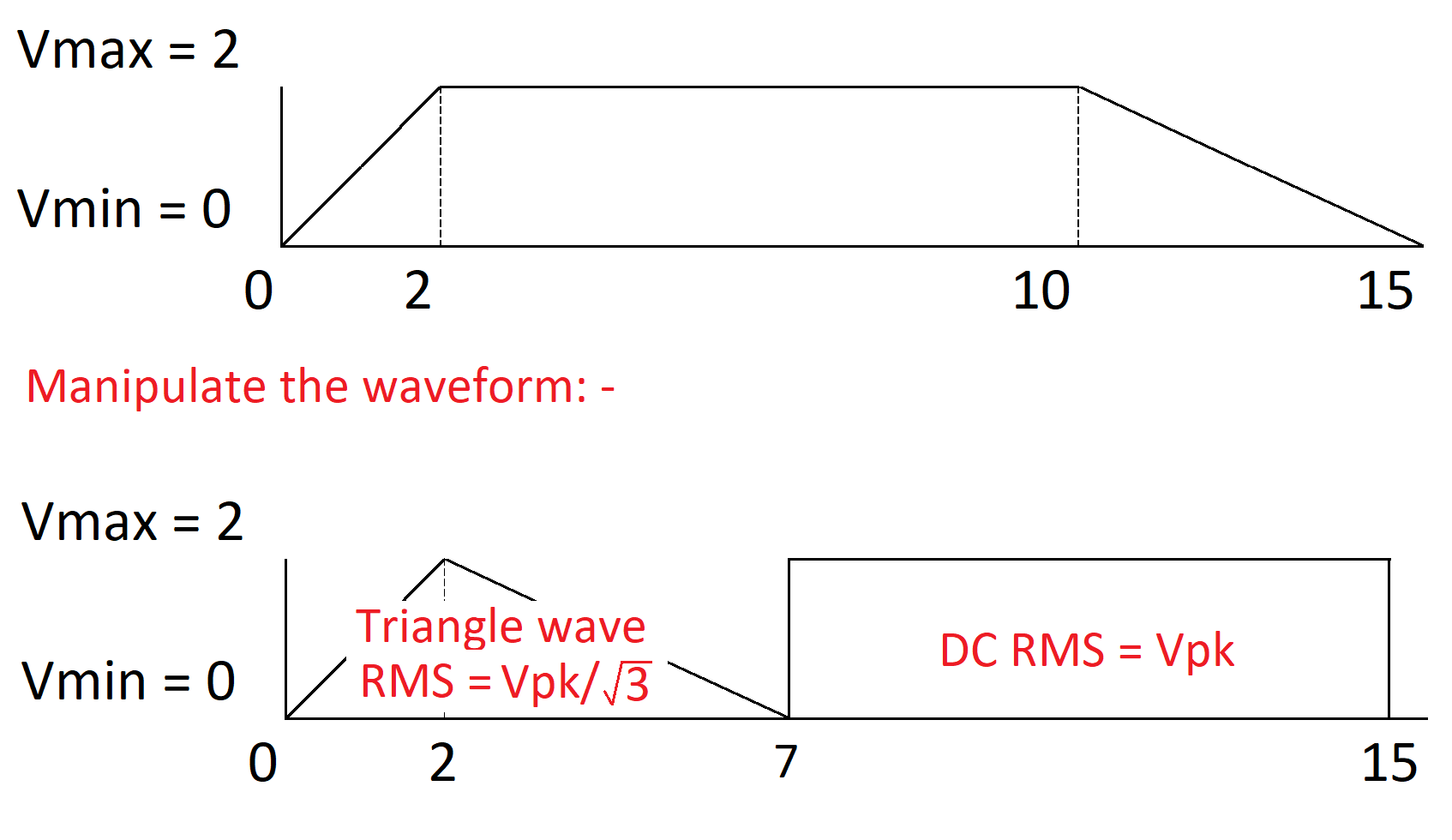The plot of voltage over time is given in below plot.
As you can see,
\$V_{max}=2v \text{ and } V_{min}=0v\$
\$t1=2ms, t2=8ms, t3=5ms, \text{ and period, } T = 15ms\$
Question is to find \$V_{rms}\$ over \$T\$
We know that $$V_{rms}=\sqrt{\frac{1}{T}\int_{0}^{T}V(t)^2dt}$$
Here's my attempt at finding \$V_{rms}\$
$$\begin{alignedat}{0} \require{cancel} V_{rms}&=\sqrt{\frac{1}{T}\int_{0}^{T}V(t)^2dt}\\ &=\sqrt{ \frac{1}{T}\int_{0}^{\frac{2}{15}T}(\frac{V_{max}}{\frac{2T}{15}}t)^2dt + \frac{1}{T}\int_{\frac{2}{15}T}^{\frac{10}{15}T}(V_{max})^2dt + \frac{1}{T}\int_{\frac{10}{15}T}^{\frac{15}{15}T}(\frac{-V_{max}}{\frac{5T}{15}}t)^2dt } \\&=\sqrt{ \frac{1}{T}\frac{V_{max}^2\cdot 15^2}{4T^2}\frac{t^3}{3}\rvert_{0}^{\frac{2T}{15}} + \frac{1}{T}(V_{max})^2(\frac{10T}{15}-\frac{2T}{15}) + \frac{1}{T}\frac{V_{max}^2\cdot 15^2}{25T^2}\frac{t^3}{3}\rvert_{\frac{10T}{15}}^{\frac{15T}{15}} } \\&=\sqrt{ \frac{1}{T}\frac{V_{max}^2\cdot 15^2}{4T^2}\cdot\frac{1}{3}\cdot\frac{2^3T^3}{15^3} + \frac{1}{T}(V_{max})^2(\frac{8T}{15}) + \frac{1}{T}\frac{V_{max}^2\cdot 15^2}{25T^2}\cdot\frac{1}{3}\cdot\frac{15^3T^3-10^3T^3}{15^3} } \\&=\sqrt{ \frac{1}{ \cancel{T} }\frac{V_{max}^2\cdot 15^2}{4\cancel{T^2}}\cdot\frac{1}{3}\cdot\frac{2^3\cancel{T^3}}{15^3} + \frac{1}{\cancel{T}}(V_{max})^2(\frac{8\cancel{T}}{15}) + \frac{1}{\cancel{T}}\frac{V_{max}^2\cdot 15^2}{25\cancel{T^2}}\cdot\frac{1}{3}\cdot\frac{15^3\cancel{T^3}-10^3\cancel{T^3}}{15^3} } \\&=\sqrt{ \frac{V_{max}^2\cdot 8}{4\cdot3\cdot15}+\frac{V_{max}^2\cdot 8}{15}+\frac{V_{max}^2\cdot(15^3-10^3)}{25\cdot3\cdot15} } \\&=\sqrt{ \frac{V_{max}^2\cdot8}{180}+\frac{V_{max}^2\cdot8}{15}+\frac{V_{max}^2\cdot2375}{1125} } \\&=\sqrt{ \frac{V_{max}^2\cdot8}{180}+\frac{V_{max}^2\cdot8}{15}+\frac{V_{max}^2\cdot2375}{1125} } \\&=\sqrt{ V_{max}^2\cdot0.04444+V_{max}^2\cdot0.53333+V_{max}^2\cdot2.1111 } \\&= V_{max}\cdot\sqrt{2.68887}=2\cdot1.639=3.28 \end{alignedat} $$
The book answer, however, shows the following method: $$\begin{alignedat}{0} \require{cancel} V_{rms}&=\sqrt{\frac{1}{T}\int_{0}^{T}V(t)^2dt}\\ &=\sqrt{ \frac{1}{T}\int_{0}^{\frac{2}{15}T}(\frac{V_{max}}{\frac{2T}{15}}t)^2dt + \frac{1}{T}\int_{0}^{\frac{8}{15}T}(V_{max})^2dt + \frac{1}{T}\int_{0}^{\frac{5}{15}T}(\frac{-V_{max}}{\frac{5T}{15}}t)^2dt } \\&=\sqrt{ \frac{V_{max}^2\cdot8}{180}+\frac{V_{max}^2\cdot8}{15}+\frac{V_{max}^2\cdot125}{1125} } \\&=\sqrt{ V_{max}^2\cdot0.04444+V_{max}^2\cdot0.53333+V_{max}^2\cdot0.1111 } \\&=V_{max}\cdot\sqrt{0.68885111}\\ &=2\cdot0.829971=1.6599 \end{alignedat} $$
Upon closer inspection, it looks like the integral for \$t3\$ is incorrect in my method, but for the life of me I can't figure out why it won't work. Where exactly did I do wrong?



